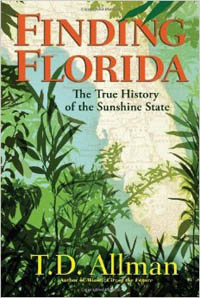From Delancey Place
This is an excerpt from Finding Florida: The True History of the Sunshine State by T.D. Allman: Ponce de Leon, Washington Irving, and the Fountain of Youth — and how the name “Florida” was chosen.
 If you go looking for the Fountain of Youth in its reputed location in St. Augustine, Florida], you’ll know you’ve almost reached your destination when you find yourself peering up at an ancient-looking arch. Across the top you’ll see displayed, in Ye Olde English-type lettering, an inscription. It reads: FOUNTAIN OF YOUTH. The lettering is meant to evoke long-vanished times of chivalry and derring-do, but one detail marks it as indubitably Floridian: the sign is made of neon tubing. In the gathering subtropical twilight, the FOUNTAIN OF YOUTH sign glows and sputters like the VACANCY sign on a state highway motel. According to press releases provided by the Fountain of Youth Archaeological Park, which is what this venerable tourist attraction currently calls itself, this is the very spot where ‘Ponce de Leon landed in St. Augustine in 1513 searching for a Fountain of Youth.’ …
If you go looking for the Fountain of Youth in its reputed location in St. Augustine, Florida], you’ll know you’ve almost reached your destination when you find yourself peering up at an ancient-looking arch. Across the top you’ll see displayed, in Ye Olde English-type lettering, an inscription. It reads: FOUNTAIN OF YOUTH. The lettering is meant to evoke long-vanished times of chivalry and derring-do, but one detail marks it as indubitably Floridian: the sign is made of neon tubing. In the gathering subtropical twilight, the FOUNTAIN OF YOUTH sign glows and sputters like the VACANCY sign on a state highway motel. According to press releases provided by the Fountain of Youth Archaeological Park, which is what this venerable tourist attraction currently calls itself, this is the very spot where ‘Ponce de Leon landed in St. Augustine in 1513 searching for a Fountain of Youth.’ …
Juan Ponce de Leon never visited and never could have visited St. Augustine: St. Augustine was not founded until forty-one years after his death, in 1565. Ponce did not discover Florida. Many Europeans had been to Florida before he got there; many more knew of its existence. The first European to sight Florida may not have been Spanish at all, but Portuguese or Italian. …
By March 1513, when Ponce and his private flotilla of three ships sailed north to claim the new land, there was no need to ‘discover’ Florida. Ponce’s expedition was meant to address a quite different question: how to secure, settle, and finance the administration of this new land that had fallen within Spain’s ambit? Conferring an official name on such a place was an important ritual, akin to baptizing a new land, but why ‘Florida’? … The significance of the name was religious. It was a custom among the conquistadors to name places according to the dates of the liturgical calendar. Columbus discovered the island of Trinidad on the feast of the Trinity, hence that island’s name. Pascua Florida was a poetic name for Palm Sunday. …
It turns out that the person most responsible for spreading the myth of Ponce and the Fountain of Youth was none other than Washington Irving, the inventor also of ‘Rip Van Winkle’ and ‘The Legend of Sleepy Hollow.’ Though today Washington Irving is remembered for his fiction, in his own time he was infamous for the liberties he took with the facts — in this case those found in the Spanish archives. No contemporary account mentions any quest for eternal youth by Ponce, or any other of the conquistadors, but in 1535, some fourteen years after Ponce died, the Spanish archivist Gonzalo Fernandez de Oviedo, without mentioning any fountain, remarked in passing that Ponce was searching for a remedy for ‘el enflaquecimiento del sexo.’ More than half a century after Ponce’s death, in 1575, a second unsubstantiated reference to Ponce appeared in a compendium of fact and fantasy dealing with an entirely different person. This one did mention a fountain.
A third volume published in 1610, nearly one hundred years after Ponce supposedly ‘discovered’ Florida, conflated this largely fictional and unrelated adventure with the history of Ponce de Leon’s actual career, while mixing in other irrelevant and fantastical details.
That was it — three baseless, passing references to Ponce de Leon over a period of nearly three hundred years, until Washington Irving turned up in Spain in the 1820s. There the brilliant young American storyteller began what he promised would be an accurate translation of Oviedo’s immense opus, which filled dozens of volumes, but Washington Irving was far too inventive to be anyone’s interpreter. Finding his undertaking tedious as well as gargantuan, Irving turned his ‘translation’ into a far briefer work, dealing only with Pizarro, Cortes, and Ponce de Leon. Then, when he got back to America, he published what he had written under his own name, not Oviedo’s. Irving, one of America’s first best-selling authors, understood the importance of comic relief. Taking Ponce’s supposed ‘enflaquecimiento’ as his starting point, he spun out a tale that is still as entertaining and deceiving as it was when he wrote it.
Thanks to Irving’s narrative skills the false Ponce became a star performer in a fiesta of illusion that persists to this day. As the five hundredth anniversary of its ‘discovery’ by Ponce de Leon approached, millionaires donated money, academics composed screeds, and politicians lauded Florida’s made-up history while people all over the state were caught up in the street parades, the beauty pageants, and, occasionally, the attempts to convene serious intellectual colloquia in commemoration of Florida’s definitive fake event.
